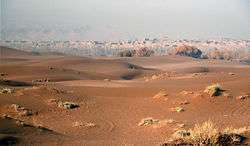Shanshan County
| Shanshan County 鄯善县 • پىچان ناھىيىسى | |
|---|---|
| County | |
|
Sheds for drying grapes in the desert outside Shanshan | |
.png) Location of the county | |
 Shanshan Location of the seat in Xinjiang | |
| Coordinates: 42°52′N 90°10′E / 42.867°N 90.167°E | |
| Country | People's Republic of China |
| Province | Xinjiang |
| Prefecture | Turpan city |
| Time zone | China Standard (UTC+8) |
Shanshan County, formerly Piqan County (Chinese: 鄯善县; pinyin: Shànshàn Xiàn; Uyghur: پىچان ناھىيىسى, Пичан Наһийиси, ULY: Pichan Nahiyisi, UYY: Piqan Nah̡iyisi?) is a county within the Xinjiang Uyghur Autonomous Region and is under the administrative jurisdiction of the Turpan city. It contains an area of 39,548 km2. According to the 2002 census, it has a population of 210,000.
The county seat is in Shanshan Town.
Name
The county is named after the ancient Shanshan Kingdom, although the kingdom was actually located mostly outside of the borders of the modern county, in the Lop Nur area. The place was originally named Piqian, and the Grand coordinator and provincial governor of Xinjiang proposed the name of Shanshan when Guangxu Emperor decided to set up a county in 1902.[1]
Paleontology
The local geology and the desert climate made it possible to discover a number of important fossil sites in the area, including China's largest cluster of fossilized dinosaur tracks and China's largest dinosaur.[2] Important dinosaur sites are associated with the Lianmuqin Formation (named after Lianmuqin Town) and the Subashi Formation (named after Subashi Village (42°55′11″N 89°44′36″E / 42.91972°N 89.74333°E) in Tuyugou Township (吐峪沟乡). The Shanshanosaurus is named after Shanshan.
In 2008-2011, a team of German and Chinese paleontologists discovered and studied an "enormous" accumulation of Jurassic turtle fossils at a site they nicknamed "Mesa Chelonia", approximately 25 km NNE of Shanshan Town. It is estimated that at least 1,800 skeletons of freshwater turtles, preliminary identified as belonging to the Annemys species were buried in this bone bed, in a stratigraphic layer probably belonging to the Qigu Formation. The researchers suggest that during a drought the turtles congregating at one of the few remaining water sources, and died there once that last water hole dried out. Then the skeletons were transported to the present location by a debris flow during a catastrophic rainfall event, forming a Konzentrat-Lagerstätte.[3][4]
According to the paleontologist Walter Joyce, the Shanshan find has more than doubled the total number of Jurassic turtle specimens known to science.[4] The excavated fossils have been transported to Shanshan Town, where they will be housed in the county museum (currently under construction).[3]
Archaeology
On January 6, 2009, five well-preserved mummies of ethnic Han men who lived during the Qing dynasty were excavated at a construction site near the Flaming Mountains in the county.[5]
Transportation
Shanshan is served by China National Highway 312, the Lanzhou-Xinjiang Railway and Shanshan Airport.
See also
References
- ↑ http://www.xzqy.net/652122000000.htm
- ↑ Large Jurassic dinosaur fossil discovered in Xinjiang, Xinhua, 2012-04-15
- 1 2 Wings, Oliver; Rabi, Márton; Schneider, Jörg W.; Schwermann, Leonie; Sun, Ge; Zhou, Chang-Fu; Joyce, Walter G. (2012), "An enormous Jurassic turtle bone bed from the Turpan Basin of Xinjiang, China", Naturwissenschaften: the Science of Nature, 114 (11): 925, doi:10.1007/s00114-012-0974-5
- 1 2 Gannon, Megan (October 31, 2012), "Jurassic turtle graveyard found in China", Livescience.com
- ↑ "Well preserved mummies found in Xinjiang", China Daily
